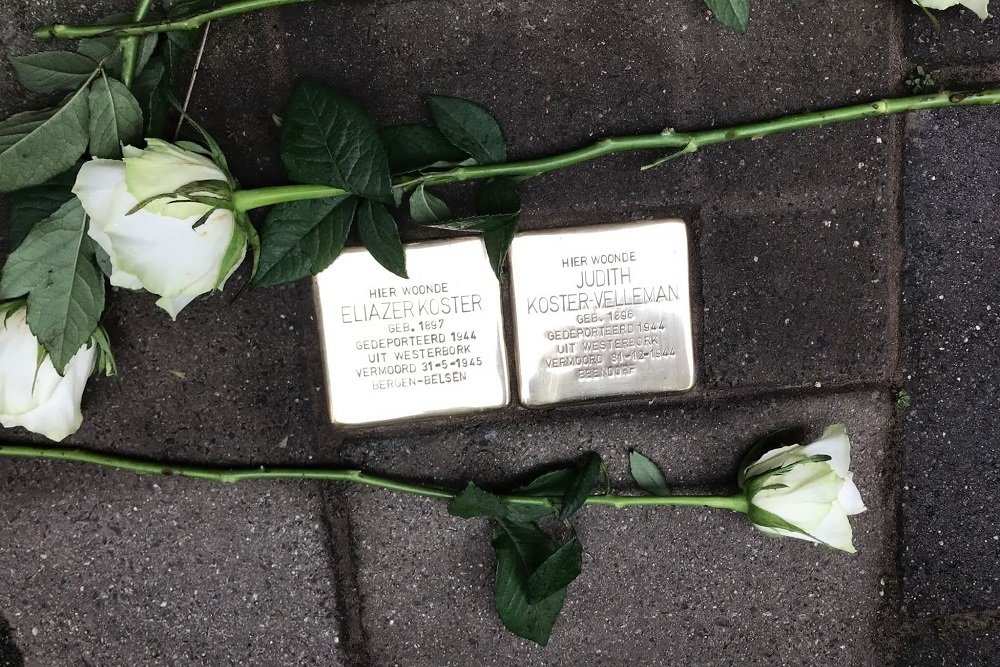Stumbling Stones Duvenvoordestraat 56
These memorial stones (so called Stolpersteine of stumbling blocks) commemorate:
family Koster
The small copper plaques, in the pavement in front of houses of which the (mostly Jewish) residents were murdered by the Nazis, mention the name, date of birth and place (mostly a concentration camp) and date of death.
In many other cities, mainly in Germany but also in other European countries, the memorials also can be found. There are already many thousands of these plaques and their number is still counting. Almost all Stolpersteine are laid by the German artist himself, Gunter Demnig.
ELIAZER KOSTER
May 2nd, 1897 (Amsterdam) - May 31st, 1945 (Bergen-Belsen)
DUVENVOORDESTRAAT 56
Eliazer Koster was the second youngest in an Amsterdam family with five children, one of whom had died as a baby. On August 17, 1921 he married Sara Keizer. He was then employed as a brakeman at the Dutch Railways. Eliazer and Sara divorced six years later.
On November 5, 1930, Eliazer married Judith Velleman, who worked as a saleswoman. From 1932 Eliazer and Judith lived in Haarlem. During the first years they lived at various other addresses and from 1939 at 56 Duvenvoordestraat. Eliazer worked as a night watchman at the synagogue of the Dutch-Jewish Community of Haarlem. This synagogue was located on the Lange Begijnestraat, where the Toneelschuur is now located.
Their daughter Vera was born on January 31, 1934. When the anti-Jewish measures started, her parents looked for a hiding place for her, first in Haarlem and later, when the address in Haarlem was no longer safe, she was placed elsewhere. Vera went into hiding at many different addresses and eventually experienced the liberation in Zaandam.
Eliazer and Judith tried to go into hiding themselves. However, they were arrested and deported to Westerbork on 20 May 1944, where they ended up in barrack 67, the penal barracks. On 31 July 1944 they were transported to Bergen-Belsen. From there, Eliazer was deported on 4 December 1944 to camp Sachsenhausen (Oranienburg), where he was imprisoned for a short time. On May 31, 1945, a few weeks after the liberation of the camp, he succumbed in Bergen-Belsen, probably from illness, malnutrition and exhaustion.
Transport from Westerbork to Bergen-Belsen on July 31, 1944.
Killed in Bergen-Belsen on May 31, 1945.
He was 48 years old.
JUDITH KOSTER-VELLEMAN
January 19th, 1896 (Amsterdam) - December 31st, 1944 (Beendorf)
DUVENVOORDESTRAAT 56
Judith Velleman grew up in an Amsterdam family with one younger brother. She was a saleswoman. On November 5, 1930 she married Eliazer Koster. They first lived in Amsterdam, but from 1932 in Haarlem, where Eliazer worked as a night watchman of the synagogue of the Dutch Israelite Community of Haarlem.
Their daughter Vera was born on January 31, 1934. Eliazer and Judith found a hiding place for her in Haarlem in 1941. When that address was no longer safe, she was moved elsewhere. Vera went into hiding at many different addresses during the war and eventually experienced the liberation in Zaandam.
Judith and Eliazer also tried to go into hiding themselves. However, they were arrested and deported to Westerbork on 20 May 1944, where they ended up in barrack 67, the penal barracks. On 31 July 1944 they were transported to Bergen-Belsen. From there, Judith was deported on December 5 to Beendorf (outer camp of Neuengamme and Ravensbrück), where she was murdered on December 31, 1944.
Transport from Westerbork to Bergen-Belsen on July 31, 1944 .
Murdered in Beendorf on December 31, 1944.
She was 48 years old.
Do you have more information about this location? Inform us!
Source
- Text: Reini Elkerbout
- Photos: Reini Elkerbout
Nearby
Museum
Point of interest
- Stelling van Amsterdam - Roman Catholic Military Hostel - Haarlem
- Stelling van Amsterdam - Protestant Military Hostel - Haarlem
- Stelling van Amsterdam - Koudenhorn Barracks - Haarlem
Monument
- Memorials Bankers of the Resistance - Bloemendaal
- Memorial Liberation 5 May 1945 Haarlem - Haarlem
- Memorial 'Woman in the Resistance' - Haarlem
Cemetery
- Dutch War Graves General Cemetery Kleverlaan - Haarlem
- Commonwealth War Grave General Cemetery Kleverlaan - Haarlem
- Dutch War Graves Roman Catholic Cemetery St. Barbara - Haarlem
Remembrance Stone
- Stumbling Stone Duvenvoordestraat 30 - Haarlem
- Stumbling Stones Duvenvoordestraat 110 - Haarlem
- Stumbling Stones Johan van Vlietstraat 81 - Haarlem
Fortification
- FLAK Stand Haarlem - Haarlem
- Atlantikwall - Regelbau 610 - Bloemendaal
- Atlantikwall - Vf Beobachter - Bloemendaal




